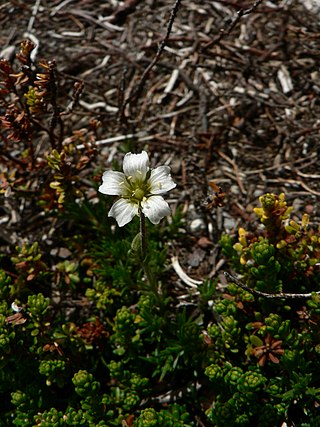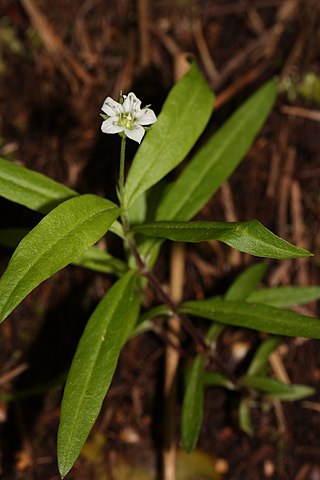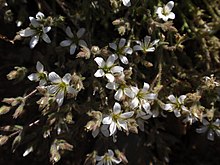
Minuartia is a genus of flowering plants commonly known as sandworts in the family Caryophyllaceae.

Minuartia obtusiloba is a perennial alpine herb known by the common names alpine sandwort and twinflower stitchwort. It is native to the mountains of western North America from the High Sierra of California to the Colorado Rockies north to Alaska. Its range may extend into far eastern Russia. This is a low plant forming mats or clumps and bearing small thimble-shaped flowers with curving white petals.

Eremogone congesta is a species of flowering plant in the family Caryophyllaceae known by the common name ballhead sandwort. It is native to western North America from central Canada to the American southwest.

Minuartia groenlandica, the Greenland stitchwort or mountain stitchwort, Appalachian stitchwort, mountain sandwort, smooth mountain sandwort, and smooth sandwort is a rare perennial which grows low to the ground in clumps linked together at the bottom. It has three to five pairs of leaves in a linear opposite pattern along the length of the slender stem. The main stem breaks into one to thirty cymes which each flower separately. The flowers are white and arise five to ten centimeters above the thick foliage. The white flower petals are six to ten millimeters long. The petals are, in turn, surrounded by five green sepals.
Minuartia californica, commonly known as California sandwort, is a species of flowering plant in the family Caryophyllaceae.
Minuartia decumbens is a rare species of flowering plant in the family Caryophyllaceae known by the common names The Lassics sandwort and Lassicus stitchwort.

Minuartia douglasii is a species of flowering plant in the family Caryophyllaceae known by the common name Douglas' stitchwort.

Minuartia howellii is an uncommon species of flowering plant in the family Caryophyllaceae known by the common names Howell's stitchwort and Howell's sandwort.
Minuartia pusilla is a species of flowering plant in the family Caryophyllaceae known by the common names annual sandwort and dwarf stitchwort.
Minuartia rosei is an uncommon species of flowering plant in the family Caryophyllaceae known by the common names peanut sandwort and peanut stitchwort.

Minuartia rubella is a species of flowering plant in the family Caryophyllaceae known by several common names, including beautiful sandwort, mountain sandwort, Arctic sandwort, and boreal stitchwort. It has a circumboreal distribution, occurring throughout the northernmost Northern Hemisphere from the Arctic Circle on the Arctic tundra into the alpine climates of mountainous areas in temperate Eurasia and North America. It grows in rocky, moist, often barren habitat, including gravelly, sparsely vegetated slopes with little organic matter. It is a calciphile, growing in calcareous substrates such as soils rich in decomposed limestone.

Minuartia stolonifera is a rare species of flowering plant in the pink family known by the common names Scott Mountain sandwort and stolon sandwort.

Minuartia stricta is a species of flowering plant in the family Caryophyllaceae known by the common names bog stitchwort, Teesdale sandwort and rock sandwort. It has a circumboreal distribution, occurring throughout much of the northernmost Northern Hemisphere from the lower Arctic into the alpine climates of mountainous areas in temperate Eurasia and North America. It grows in several types of habitat, including meadows, marshes, heath, beaches and bars, and arctic and alpine tundra.

Moehringia macrophylla, commonly known as the largeleaf sandwort, is a species of flowering plant in the family Caryophyllaceae. It is native to parts of eastern and western North America, where it can be found in moist, shady habitat types, such as mountain forests. It is a rhizomatous perennial herb growing erect to about 18 centimeters in maximum height. The lance-shaped leaves are up to 5 centimeters long and oppositely arranged about the stem. The inflorescence is a cyme of 2 to 5 flowers, each with 5 pointed green sepals and 5 rounded white petals. The fruit is a toothed black capsule.
Minuartia cismontana is a species of flowering plant in the family Caryophyllaceae known by the common name cismontane minuartia.

Minuartia cumberlandensis is a rare species of flowering plant in the pink family known by the common names Cumberland stitchwort and Cumberland sandwort. It is endemic to the Cumberland Plateau near the Big South Fork of the Cumberland River in Tennessee and Kentucky. This rare plant is found only in cool sandstone rock shelters, on the moist sandy cave floors behind the drip line. There are 27 occurrences in Tennessee and one in Kentucky. The plant is a federally listed endangered species.

Minuartia patula, common names pitcher's stitchwort or lime-barren sandwort, is an annual plant in the family Caryophyllaceae. It is native to sections of the eastern and central United States, primarily the lower Mississippi Valley, the southern Great Plains, and the Tennessee Valley, with additional scattered populations in Georgia, Virginia, Pennsylvania, and the southern Great Lakes region.
Minuartia yukonensis, the Yukon sandwort or Yukon stitchwort, is a plant species native to Yukon and Northwest Territories of Canada, as well as Alaska, and The Russian Far East. Flora of North America and some other publications also report it from British Columbia, but more recent work shows those collections to have been misidentified. Minuartia yukonensis grows in dry, rocky meadows at elevations less than 1000 m.

Minuartia recurva, the recurved sandwort or sickle-leaved sandwort, is a rare tufted, calcifugous chamaephyte perennial flowering plant in the family Caryophyllaceae. It blooms from late spring to the end of summer.














